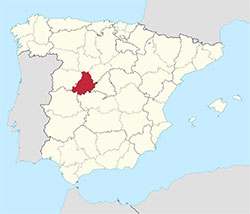Ávila in Ávila

The province of Ávila is situated in Castilla y León and borders the provinces of Valladolid, Salamanca, Cáceres, Toledo, Segovia and Madrid. The province covers and area of 8,051.15m2 and has a population of 167,015 souls giving it a population density of 27.75 inhabitants per km2. The province’s claim to fame is the fact that it is the province with the highest average altitude in Spain at 1,022.59m. The capital of the same name boasts a similar distinction: At 1131 m above sea level it is the highest provincial capital in Spain. With its population of 58,083 (2016) and is one of Spain’s least populated capitals.
It boasts no less than three titles which were bequeathed by three different kings: Áviladel Rey (king) by King Alfonso VII, Ávila de los Leales (loyal) by King Alfonso VIII and Ávila de los Caballeros (Knights) by King Alfonso X. All three kings had at one time or another been protected and helped in the city against various prosecutors. Being as high as it is, it is natural that the climate should be quite fresh, and indeed the average temperature for the whole year is a shivery 11ºC! The winters are cold and snowy and often the temperature drops below freezing.
 The summers are warm, though, with the daytime temperatures averaging the high twenties, but even that time of year the nights are cool at between 10 and 15ºC.Precipitations are usually plentiful from October to April; however,the summers are dry and before proper water supply to the city was secured, droughts in summer were a common occurrence. One of the city’s main sources of income is tourism, and it is a treasure trove of historical and religious buildings, and of course the famous wall that surrounds the whole of the old city is a must see for any visitor – in fact you cannot avoid seeing it as you approach the city!
The summers are warm, though, with the daytime temperatures averaging the high twenties, but even that time of year the nights are cool at between 10 and 15ºC.Precipitations are usually plentiful from October to April; however,the summers are dry and before proper water supply to the city was secured, droughts in summer were a common occurrence. One of the city’s main sources of income is tourism, and it is a treasure trove of historical and religious buildings, and of course the famous wall that surrounds the whole of the old city is a must see for any visitor – in fact you cannot avoid seeing it as you approach the city!
However, probably due to the city’s limited size,the average time of overnight stays is just one night. Archeological findings in Ávila indicate that there were settlements there already in Celtic times, but the first actual fortifications on this hill top on the Castillan plateau were built by the Romans.After the Romans left the city changed between Moorish and Christian rule for centuries, until Alfonso VI finally ousted the Muslims in 1090. He also extended the fortifications, and the wall we see today dates back to the 1100s although it has been extended and renovated over the centuries. The wall is 10m high and three meters wide and boasts an impressive 88 towers and rooks. It stretches 2.5 km round the town and there are nine gates leading to the old part of the city.Inside the wall, the Cathedral of Christ the Saviour dominates the townscape. The apse of the cathedral forms part of the fortification wall, and at the front it has one of the oldest Gothic cathedral façades in Spain.
It is not possible to walk all the way round on top of the wall, but there are two access places that allow you to get up on the wall and walk along for a distance.In 1884 the wall was declared a National Monument and since 1985, the old town of Ávila with its wall and the churches of San Vicente,San Pedro, San Andrés and San Segundo have been considered World Heritage by the UNESCO. Of course there is more to Ávila than history, and a natural follow onto the tourism it generates is a very large service sector. The gastronomy is well worth exploring, and the restaurants of Ávila offer a large variety of warming dishes to help you through the cooler times of the year. One of the famous specialties is the Chuletón (steak) de Ávila, which is actually a T-bone steak, and this one comes from the local beef cattle, the Vaca Avileña NegraIbérica, and it is superb! Other specialties include Patatas Revolcanas, potatoes mashed with paprika served with meat, Mollejas de Ternera, veal sweetbreads,and Yemas de Avila, small cakes.
History
The first recorded inhabitants of Ávila were the Celts, who left behind a number of large stone statues of bulls called Verracos, with the largest number of surviving examples in Ávila. The area of the province was conquered by the Romans around 192 B.C. After the Roman Empire fell, the area became part of the Visigothic Kingdom, and it is from this period we have many of the earliest records of the towns of Ávila.
The province declined in wealth and population during the 18th and 19th centuries, a result due less to the want of activity on the part of the inhabitants than to the oppressive manorial and feudal rights and the strict laws of entail and mortmain, which acted as barriers to progress.


